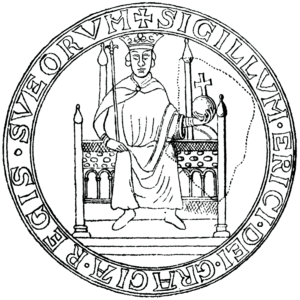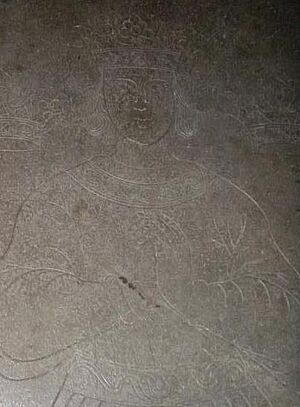Eric XI of Sweden facts for kids
Quick facts for kids Eric XI |
|
|---|---|

The seal of king Eric XI of Sweden
|
|
| King of Sweden | |
| Reign | 1222 – 1229; 1234 – 1250 |
| Predecessor | John I |
| Successor | Valdemar |
| Born | 1216 |
| Died | 2 February 1250 Sweden |
| Spouse | Catherine Sunesdotter |
| House | Eric |
| Father | Eric X |
| Mother | Richeza of Denmark |
Eric XI (born 1216, died February 2, 1250) was a king of Sweden. He ruled twice: first from 1222 to 1229, and then again from 1234 to 1250. Eric was the last king from the House of Eric. He was often overshadowed by powerful leaders called Jarls, especially his brother-in-law, Birger Jarl. Birger's family later became kings of Sweden after Eric's death.
Contents
Eric's Early Life
Eric was the son of Eric X of Sweden and Richeza of Denmark. He was born in 1216, after his father, King Eric X, had already passed away.
A old Swedish story, Erikskrönikan, says that Eric had a lisp and walked with a limp. This is why later historians called him "Erik the Lisp and Lame." However, people in his own time probably didn't use this nickname.
When Eric was born, a rival family's leader, John I, became king. Eric's mother, Queen Richeza, went back to her home country, Denmark. Eric grew up there, and his uncle, Valdemar Sejr, who was the king of Denmark, supported Eric's claim to the Swedish throne.
In 1222, King John I died. This meant there were no more male heirs from his family, the House of Sverker.
Eric's First Time as King
Because there were no other kings from rival families, the six-year-old Eric was chosen as king of Sweden. This happened between August 1222 and July 1223. He was crowned in Strängnäs Cathedral on July 31, 1223.
Since Eric was so young, a group of important people, called a council, helped him rule. This council included bishops and other powerful nobles. In 1225, the Pope offered his protection to Eric and Sweden.
However, the council members didn't always agree. In 1229, a group of nobles called the Folkung Party, led by Knut the Tall, rebelled against Eric. Eric was defeated in a battle called Olustra. After losing, the young king had to flee back to Denmark, where his uncle Valdemar Sejr was still king. Knut the Tall then became King Canute II in 1231, but he died a few years later in 1234.
Eric's Second Time as King
After King Canute II died, Eric returned to Sweden. He was accepted as king again and ruled until his own death in 1250. He made peace with the Folkung Party.
During his second reign, Eric was seen as a kind king. The Erikskrönikan describes him as someone who liked to do what was right and cared for his family. He kept peace for the common people. However, he also relied heavily on stronger men around him.
First, he depended on Ulf Fase, who was a powerful leader called a Jarl. After Ulf Fase died in 1248, Eric relied on Birger Magnusson, also known as Birger Jarl. Both Ulf and Birger came from the important Bjälbo family.
Around the late 1230s, Eric's older sister, Ingeborg, married Birger. Birger was also said to have royal blood through his mother, who was from the Sverker family.
Expedition to Finland
In the early 1200s, Sweden had some presence in southwestern Finland. The Erikskrönikan tells about a military trip to Tavastia, a region in Finland. King Eric sent this expedition, possibly in 1238–39 or 1249–50. The goal was to spread Christianity to the people there.
A large fleet of ships, led by Birger Jarl, sailed to Tavastia. The old story says the expedition was a big success. The Christians fought the local people, called Tavasts, and won. Those Tavasts who agreed to become Christians and be baptized were allowed to live in peace. Those who refused were defeated.
This expedition led to a permanent fort being built in Tavastia. It also helped to formally Christianize the region. Some historians think this event might be connected to a Swedish attack on the Novgorod Republic in 1240. In that event, a Swedish fleet was defeated by Prince Alexander Nevsky of Novgorod.
Later Conflicts and Birger Jarl's Rise
In 1247, fighting broke out again in Sweden. The Folkung Party, along with their peasant allies, fought against King Eric and Birger Jarl. The Folkung's peasant allies lost a battle called Sparrsätra. As a result, the king increased taxes on them. The Folkung leader, Holmger Knutsson, who was the son of Canute II, was captured and executed.
Soon after this uprising was put down, Birger Jarl was officially made the Jarl of Sweden. In this role, he helped organize an important church meeting in Skänninge in 1248. At this meeting, the church leaders agreed to follow the rules set by the Pope in Rome. This made the power of the bishops stronger and brought Sweden closer to the main Catholic Church.
Family and Succession
Eric married Queen Catherine in 1243 or 1244. She was the daughter of Sune Folkason of Bjälbo and came from the House of Sverker. This marriage helped to unite the two royal families that had been rivals for a long time.
Most sources say that Eric did not have any children who lived. However, some old stories mention that he might have had a couple of baby daughters who died young.
King Eric XI died on February 2, 1250. He was buried in the Varnhem Abbey monastery in Sweden. With his death, the male line of the House of Eric ended.
Because Eric had no surviving children, the throne went to the sons of Birger Jarl and Eric's sister, Ingeborg. Their oldest son, Valdemar, who was still a child, was chosen as the new king in 1250. Birger Jarl became the Regent, meaning he held the real power in Sweden until he died in 1266.
Images for kids
See also
 In Spanish: Erico XI Eriksson para niños
In Spanish: Erico XI Eriksson para niños




